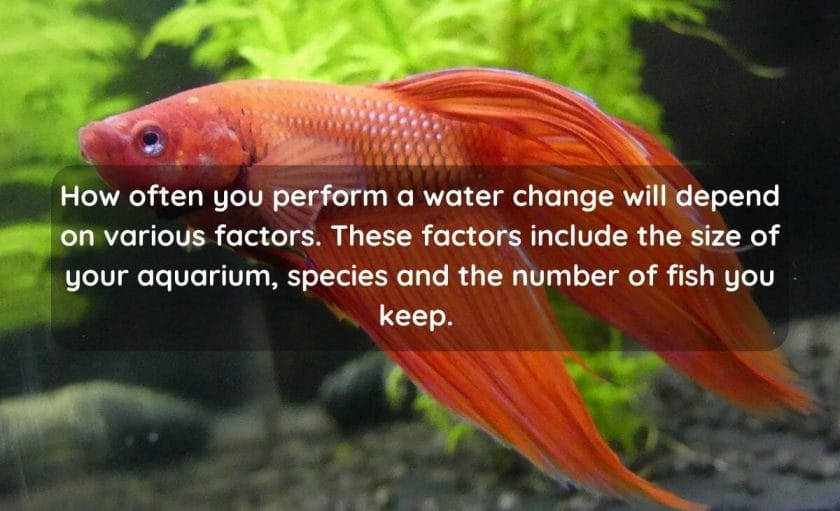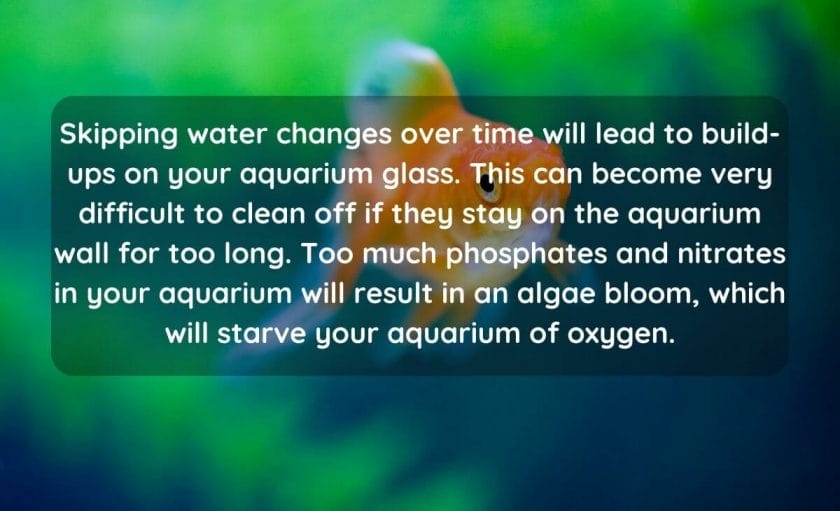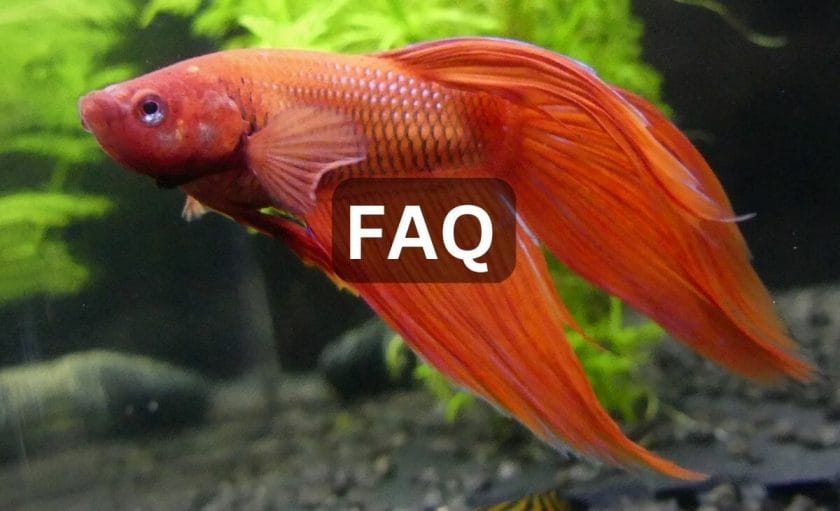Water change is important, especially if you want to give your fish the best quality of life. Hence, responsible hobbyists often ask, “Do you remove fish during fish during a water change?”
Removing fish from the aquarium during a water change is not recommended because it increases the risk of stress and shock due to the sudden change in the water parameters. Keep fish in the aquarium during water change so that the fish will adjust to the slowly changing water parameters.
Read on to learn the best way to perform a water change without stressing or killing your fish, why, and how frequently you should perform the water change.

Table of Contents
What Is a Water Change?

Water change is a maintenance routine to keep nitrite and ammonia levels low.
When performing a water change, you simply take out 10-25% of your aquarium water and replace it with fresh water that does not have any chemicals or other contaminants.
Water changes are necessary because the quality of your aquarium water can lengthen the lifespan of your fish and improve its health, well-being, and quality of life.
Water changes on a regular schedule also help to reduce the amount of waste, harmful by-products, and algae bloom that threaten the health of your fish.
Why Shouldn’t You Remove Fish During Water Change?

You should not remove fish during water change because any rapid change in the water parameters will stress the fish.
Leave the fish in the aquarium as you top the new water during the change.
This is best as it will allow your fish to slowly experience the change in water parameters so that it can adjust its body to the changing environment.
When you change the water parameters in the aquarium and dump your fish into a new environment, your fish will experience stress and shock in some cases from the sudden change in the water parameters.
You also risk hurting your fish when you remove them from the aquarium for a water change. The fins can get entangled in the net. The container where you want to keep the fish could have some contaminants from the residues of detergents or other cleaning agents you used to clean it.
This could affect your fish’s health. So it would be best to leave your fish in the aquarium when performing a water change.
How To Properly Change Aquarium Water Without Stressing Fish

While you may be tempted to remove most of the water, the proper way to perform a water change is to take out only 10-25% of the aquarium water.
How much water you take out will depend on the size of your aquarium.
It would be wrong to change most or all of the aquarium with the mindset that it will be good for another month or two.
This has many bad implications for your fish, as large water changes can rid the aquarium of a good load of denitrifying bacteria, which will reset the nitrogen cycle of your aquarium. (While large water changes will not directly remove the denitrifying bacteria, you may accidentally allow the bacteria to dry out, causing the bacteria to die off.)
Large water changes can also make your aquarium water parameters unstable for your fish. All these can affect your fish’s immunity to diseases and increase its stress levels.
The proper way to perform a water change is to consistently change only 10-25% of your aquarium water. This will keep your water chemistry and parameters as stable as possible.
It will also limit the stress levels of your fish since the environment is not changing rapidly.
Properly Performing a Water Change (Step By Step)
- To properly perform a water change for your aquarium, you must first unplug your aquarium accessories. You do not want to get them damaged from the water change.
- Take out 10-15% of your aquarium water into a bucket. Exactly how much water you should drain from the aquarium will depend on your tank size and the number of fish in your aquarium. For ex.., if you use a small, scarcely populated tank, you can change 10% every week. But if you are keeping messy fish like Goldfish in a relatively smaller tank then you may need to change more of your aquarium water on a weekly basis.
- You’ll need a bucket and a siphon for draining the old aquarium water.
- Before draining the old water from your aquarium, you should scrub your aquarium glass wall from the inside to remove any debris or algae.
- Once that’s done then drain the necessary amount of water from your fish tank into the bucket with a siphon. While draining the water, you need to work very slowly so you do not harm or startle your fish. But as you siphon, you also want to ensure you do not let the tank water level go down below 25%. This will prevent any shock for fish due to a sudden change in their environment.
- Now you’ll need to add new water into the aquarium.
- When adding the new water to your aquarium, ensure that you do not use a container with soap residues.
- You should also dechlorinate the tap water before using it for the water change.
- Test the water parameters using a test kit to confirm that you have the appropriate water parameters. Plug your filter and other aquarium accessories.
- Also, do not clean the substrate and the filter on the same day. This will disrupt both locations of the denitrifying bacteria. It would be best to clean one during the water change and the other on another day so that you do not disturb all the beneficial bacteria simultaneously.
Note: The process is the same for a saltwater aquarium. But there are minor differences. You will need a bucket to premix the aquarium salt since this is a saltwater aquarium. Do not use tap water for a water change because it usually contains chlorine, chloramine, and many other contaminants that will harm your pet. If you must use tap water, you want to dechlorinate it before using it for a water change.
When Can I Do a 50% Water Change?
Although a 50% change is not necessary, there are times when you may need to perform a 50% water change.
These include:
- when there is a spike in ammonia and nitrite levels
- When there is a chemical leak into the aquarium from an aquarium care product.
When these happen, you want to perform a 50% water change daily until the water parameters become stable again. Once stable, you can revert back to the 10-20% water change per week.
How Often To Perform A Water Change?

How often you perform a water change will depend on various factors. These factors include how densely packed your aquarium is, the size of your aquarium, the species and the number of fish you keep, and how much waste they produce.
Generally, aquariums with messier and larger fish species like Cichlids, Goldfish, Oscars, and Plecos should undergo water changes more frequently than tanks with less messy fish.
For example, a 20 gallon tank with less messy and small fish, like Bristle-nose catfish and some Tetras will require less frequent water changes. A 20% water change every 14 days will suffice.
But the same setup with a few cichlids or goldfish will require a 10-15% or more water change every 7 days, depending on how much you feed and how much waste they produce.
Also, heavily stocked aquariums such as a community tank with various species will need a more frequent water change than a sparsely occupied aquarium.
You want to change 10-15% of the aquarium water every 7 days if your aquarium is sparsely occupied. But if your aquarium is scanty, you want to take it up a notch, preferably 20% every 7 days.
Although you can let a sparsely populated tank for a maximum of 14 days before a water change, it is imperative that you do not let it exceed 14 days before a water change. If you push it any further, you risk stressing your fish.
If you have a heavily planted aquarium, you can afford to change the water once every 14 days since the plants consume nitrates. But you cannot stop performing water changes because your aquarium is heavily planted.
What Will Happen If I Don’t Change Aquarium Water?

Failing to change your water because it looks clean can lead to several issues for your aquarium. Below are some of the most common results of failing to change your aquarium water.
An Unsightly And Foul-Smelling Aquarium
The first and most common issue is an unpleasant and smelly aquarium. Skipping water changes over time will lead to build-ups on your aquarium glass.
This can become very difficult to clean off if they stay on the aquarium wall for too long.
Your aquarium may also begin to give off a foul odor.
Algae Bloom
Apart from the ugly sight of the build-up on your aquarium glass, and the unpleasant odor from your aquarium water, your aquarium will also experience an algae bloom.
Failing to perform water changes can lead to high levels of phosphates and nitrates, which will spur the growth, and bloom of algae in your aquarium. Remember that phosphates are products of waste in your aquarium, which usually includes uneaten fish food, fish waste, and decaying plants.
Too much phosphates and nitrates in your aquarium will result in an algae bloom, which will starve your aquarium water of oxygen, and make the aquarium inconducive for your fish.
This will affect your tank’s water chemistry, and your fish’s health by making your fish susceptible to diseases.
But when you perform water changes, you reduce the chances of all these negative effects of failing to perform water changes, providing your fish with a conducive environment.
FAQ

Is Too Much Water Change Advisable?
Water changes are necessary for preventing debris build-up in the substrate, on the aquarium’s glass walls, and spikes in ammonia and nitrite levels.
But changing the water too often, and changing more than 10-25% of the tank water negatively impacts the stability of your water parameters.
Can I Use Natural Sea Water For Water Change in a Reef Aquarium?
Natural sea water is often a better water source than tap water, and a commercial salt mix, even though the salinity level may vary.
But be sure to get it from sources far from chemical plants and high-traffic harbors. You risk using contaminated seawater when you collect from such places.
Conclusion
Removing your fish from the aquarium when performing a water change is unnecessary. Leave the fish in the aquarium as you perform the water change so that it can adapt to the slowly changing environment.
But beyond that, use the tips above to avoid costly mistakes when performing a water change.
Follow the water change process, and the recommended frequency discussed above.
As discussed above, even if your aquarium water looks clear, consistently perform your weekly water change to prevent the negative consequences of failing.
If you’re new to the aquarium hobby then I highly recommend you to read this article where I’ve mentioned the most common mistakes beginners make with their aquariums.